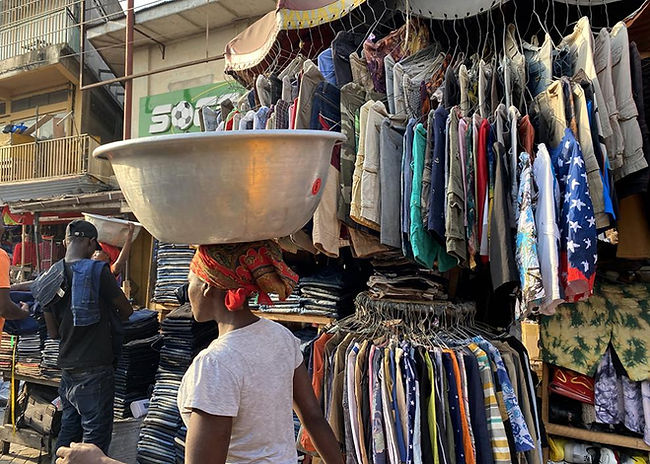By Sherin Samuel
THE TIMELINE
Consumers go through their closets and find clothing items they're no longer in need of.

Consumers put second hand clothing in a bag to donate to a local donation bin or donation clothing center. Stores sell these donated clothes to people for an extremely low price.

Whatever the donations stores aren't able to sell out on their sales floor gets sold to textile merchants. These merchants export the clothes out to third world countries.

Dr. Anika Kozlowski, Assistant Professor of Fashion Design,
Ethics & Sustainability at Ryerson University
Countries like Pakistan, which have grading facilities take the clothes. At these facilities, the worn textiles are organized and sorted into different clothing types, and then put together to make a "clothing bale."

Branson Skinner, co-founder of The OR Foundation
Clothing bales then get sold by the pound to retailers in the Kantamanto Market located in Accra, Ghana. Retailers try to sell all the contents of the clothing bales to shoppers in the market, within the week to make profit.

Courtesy of The OR Foundation
The question that remains is where are many of those unsold items going if they are not sold by the pound at outlet stores?
A “Fact Sheet” provided by the Goodwill Industries of Southern New Jersey, states “Donated goods not sold in its retail stores are sold to salvage companies that produce industrial rags and sell to Third World countries.” It can be cheaper for charity stores to sell unwanted items to other distributors than to dispose of it in the US.
The alternative of diverting the clothes to another seller, who in turn exports them to third world countries, is one that benefits clothing donation stores but can harm third world countries such as Ghana.
Dr. Anika Kozlowski, an Assistant Professor of Fashion Design, Ethics & Sustainability at Ryerson University in Toronto, Canada, claims that some companies portray this false idea of donating clothing to third world countries when in reality it is being sold.
It is tricky to track exactly which textile merchants are taking these clothes where. Dr.Kozlowski says that is due to the bankable success of the export business of textile waste.
“What are the tensions that are going to rise if you do try to start restricting and having it recirculate here because that is such a profitable business and hidden for a reason? It's very difficult to find these exporters and sorters and even get in touch with them,” Dr. Kozlowski said.
The East African Community (EAC) did just that, in terms of restrictions. In 2016, they agreed to a complete ban of used clothing imports, starting in 2019. The EAC asserted that the second hand market was causing local clothing markets to fail.
This has posed a threat for the Secondary Materials and Recycled Textiles Association, claiming that the ban would impose “significant economic hardship on the U.S. used clothing industry.” In turn, this has initiated a response from the office of the US Trade Representative threatening to remove the East African countries of Kenya, Uganda, Tanzania and Rwanda from the Africa Growth and Opportunity Act (AGOA). AGOA provides African countries with duty-free access to exported products from the US, greatly benefiting said countries’ economies.
If more countries would have followed the EAC’s ban on second hand clothing, it would start to have long lasting harmful effects for the US. In 2016, the country received $576,017,440 just on the exports of worn textiles around the world. Comparably, there was an almost $300 million increase in 2021 that the US exported second hand clothing to a value of $830,963,673, according to the United Nations Comtrade database.
In more recent years, the US has exported $6 to $5 million worth of second hand clothing to Ghana, while the United Kingdom reins in a whopping $70 to $80 millions of worn textile exports to the West African country. This doesn't mean the US isn't at fault, they also dump the second hand clothing industry to countries like Chile, where they are near numbers to those of the UK. In 2021 the US had a trade value of $81,159,075 due to the exports to Chile.
What does this relocation of the second hand clothing industry look like for Ghana specifically? The phrase “dead white man’s clothing” has erupted in the Ghanian city of Accra for the mass abundance of clothing that has created a dumping ground in their communities.
Mountains of textile waste reach heights of up to 30 feet and more, while lines of clothing span over the beaches and villages. It’s more than just an eye sore, because once the rain makes the cloth wet, it can cause the illness of cholera and attracts mosquitoes which can spread malaria.


